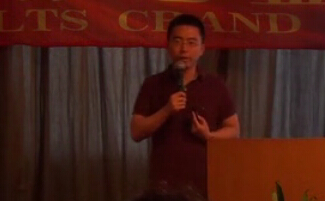雅思阅读模拟练习题(6)
2013-07-30 12:20 供稿单位: 新航道
出国英语考试有哪些 雅思6.5是什么水平 雅思阅读评分标准 托福阅读评分标准 雅思和托福的区别
You should spend about 20 minutes on questions 14-26, which are based on Reading Passage 2 below.
Question 14
Choose the most suitable title for Reading passage 2 from the list below. Write your answer in box 14 on your answer sheet.
A Old Remedies Still Work Today.
B The Forest Pharmacy.
C Miracle Cure From Nature.
D A Modern Cure For An Ancient Killer
A
The search for cures to treat common diseases is not new, nor is it unusual to find the cures for such diseases in tree bark. Aspirin for headaches and quinine for the treatment of malaria are both examples of modern medicines which have been derived from tree bark. But the latest additions to this list may be the most significant yet, according to the findings of research into the medicinal benefits of the bark of the African Bush Willow. At an international conference, Dr Scott Remick of the USA claimed that combretastin, a product of this bark, has proved up to 85% effective in combating cancer, and may, in combination with chemotherapy, finally provide a way to destroy many types of tumour.
B
The African Bush Willow, which grows in South Africa, has been recognised as a medicinal plant by local tribespeople for many years. In the past, its roots were used as purgatives and its gum was used to treat sores and ulcers. Common along river banks in southern Africa, this plant (scientific name, Combretum caffrum) has proved both hardy and prolific, It is one of the world's fastest-growing trees and can grow one metre in height annually to a maximum of fourteen metres. To sustain this level of growth normally requires warmth, rich soil and abundant water. but even when these are in short supply, the African Bush Willow can survive. It is resistant to severe drought and even sustained periods of frost, and temperatures well below zero do not damage the tree.
C
Combretastin, the active ingredient in the bark, was originally isolated form the stems and branches in the 1970a by South African researcher, Dr Gordon Cragg. A massive seventy-seven kilogrammes of material was needed from the tree to produce just a few milligrams of the active ingredient. However, scientists have now been able to produce the drug synthetically. This type of manufacturing has meant that the drug can now be mass-produced and used much more widely in the treatment of cancer. Most cancers are caused by tumours, which create their own network of capillaries to supply the blood they need in order to grow. The effect of combretastin is to reduce the tumour's ability to create these capillaries and thereby starve the tumour to death.
D
Combretastin appears to work very quickly, often reducing the blood flow to a tumour within four to six hours after its first application. A feature in its favour is that combretastin does not appear to affect the blood supplies to other healthy organs. But, used in isolation, a small number of cancerous cells which appear able to live off normal blood supplies, appear to remain unaffected by combretastin, and radiation therapy is required to destroy these cells and remove the threat of cancer altogether.
E
Initial trials have been carried out on twenty-five patients in the USA. These have met with a remarkable measure of success. One 55-year-old man, suffering from a particularly aggressive form of thyroid cancer before treatment, has been cancer-free for two years following a course of the new drug. It is generally held that if a cancer does not return within two years of treatment, it has been cured. So far, other patients involved in the trials since then, including those with cancer of the bowel, have also remained clear of their cancers.
F
Trials in the UK have met with similar success, but have reported significant side effects, including diarrhoea and skin pain. In Britain, experts believe that the drug works best in conjunction with other therapies, including radiotherapy. The results of these combined treatments suggest that 85% of cancers could be totally eliminated, and similar trials are due to start in the USA. Dr Kate Law of the Cancer Research Campaign in London comments, "We will be watching the results of these trials with interest. On the face of it, these latest trials are very encouraging.
G
The drug has been greeted with enthusiasm by professionals and patients alike despite some of the experiments having limited success. One patient suffering from lung and liver cancers agreed to be one of the guinea pigs in the pharmaceutical trials. Fortunately he met with a degree of success in that his respiratory organs have been clear for over a year. However, this has not been the case with the other source of cancer and as yet the new drug has had no marked effect on it. Nevertheless, researchers are continuing in their quest to find a cure for all forms of cancers and they are confident that a breakthrough is on the horizon.
Questions 15-17
Choose the best answers A, B, C or D. Write your answers in boxes 15-17 on your answer sheet.
15. The active ingredient of combratastin was found in which part of the tree?
A the gum B the branches
C the roots D the leaves
16. According to the text, medicines NOT derived from tree bark, have been used to cure which condition?
A sores B malaria
C cancer D migraine
17. According to the text, which of the following has not as yet been cured using combretastin?
A bowel cancer B thyroid cancer
C liver cancer D lung cancer
Questions 18-20
Write NO MORE THAN THREE WORDS from Reading Passage 2 for each answer, Write your answers in boxes 18-20 on your answer sheet.
18 Researchers believe that advances will be made in ...... in finding cures for all types of cancer.
19 The African Bush Willow is extremely sturdy and can survive long intervals in very low ...... .
20 In Britain, researchers believe that most cancers can be cured using combretastin together with ...... .
Questions 21 - 26
Reading Passage 3 has seven paragraphs, A-G. Choose the most suitable headings for paragraphs B-G from the list below. Write the appropriate numbers i-x in boxes 21-26 on your answer sheet.
There are more headings than paragraphs, so you will not use them all.
List of Headings
i Strange Medicine vi Ongoing Research
ii How the Drug Works vii Research Campaign
iii Robust and Versatile viii Artificial Substitutes
iv Plants Growing ix Happy Patients
v Universal Approval x Additional Consequences
21 Paragraph B ...... 22 Paragraph C ......
23 Paragraph D ...... 24 Paragraph E ......
25 Paragraph F ...... 26 Paragraph G ......
参考答案:
14. C 15.B 16. A 17.C 18. the (near) future 19. temperatures
20. other therapies/radiotherapy 21. iii 22. viii 23. ii 24. ix 25. vi 26. v
以上就是新航道雅思频道为大家整理的雅思阅读模拟练习题(6),希望对大家有帮助,更多资讯、资料请访问新航雅思真题频道 https://www.xhd.cn/ielts/yucezhenti/
- 上一篇:雅思阅读模拟练习题(7)
- 下一篇:雅思阅读模拟练习题(5)
分享到:

- 新航道,英语成功之道。时间获取新航道英语学习资料和新鲜资讯,请在微信公众账号中搜索「新航道英语」或者「xhdenglish」,或用手机扫描左方二维码,即可获得新航道每日精华内容推送和英语学习经验分享,并参与新航道举办的各项活动。
责编:李术
精彩专题
更多视频荟萃
更多
-
新航道姚骏鹏-雅思阅读高分攻略
时长:03-06

-
新航道陈侃侃-雅思口语要有范儿
时长:03-06

-
【3分钟学雅思】王大锤告诉你为啥药不能停
时长:01-12

-
【3分钟学雅思】全世界个感官餐厅
时长:01-12
热门文章
更多
-
8月31日雅思广州考机考初体验
选择机考模式的考生将通过机考模式参加听...








